
The Solar-Terrestrial Centre of Excellence (STCE) is a collaborative network of the Belgian Institute for Space Aeronomy, the Royal Observatory of Belgium and the Royal Meteorological Institute of Belgium.
 |
Published by the STCE - this issue : 12 Feb 2015. The Solar-Terrestrial Centre of Excellence (STCE) is a collaborative network of the Belgian Institute for Space Aeronomy, the Royal Observatory of Belgium and the Royal Meteorological Institute of Belgium. |
| Archive of the newsletters | Subscribe to this newsletter by mail |
A movie of the transit of the filament and its almost eruption on 04 February 2015 in both H-alpha and EUV is available at http://youtu.be/A_YNsU1nZ2E
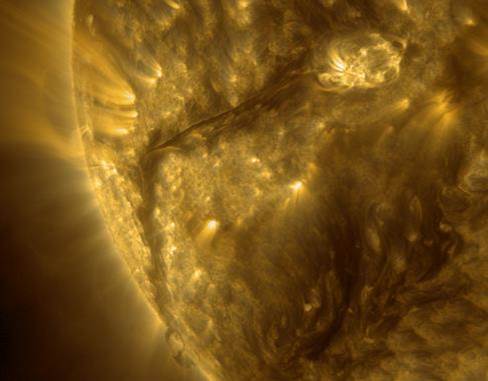
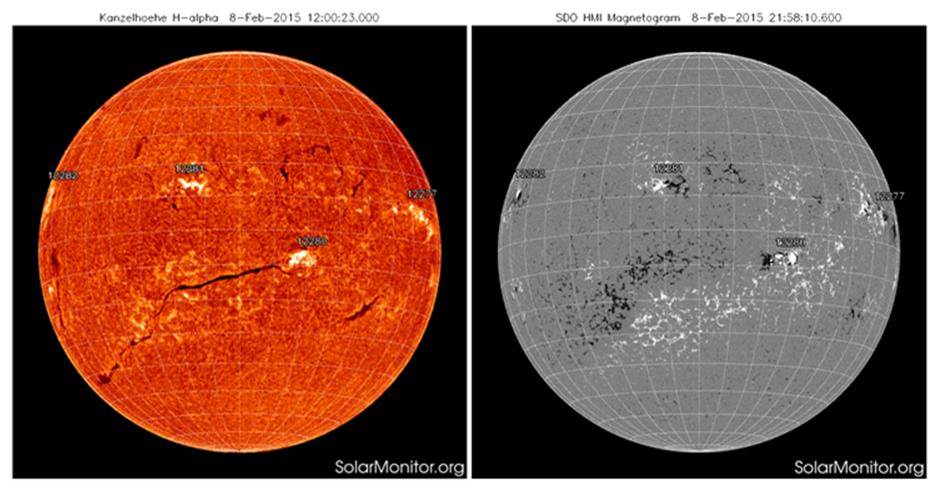
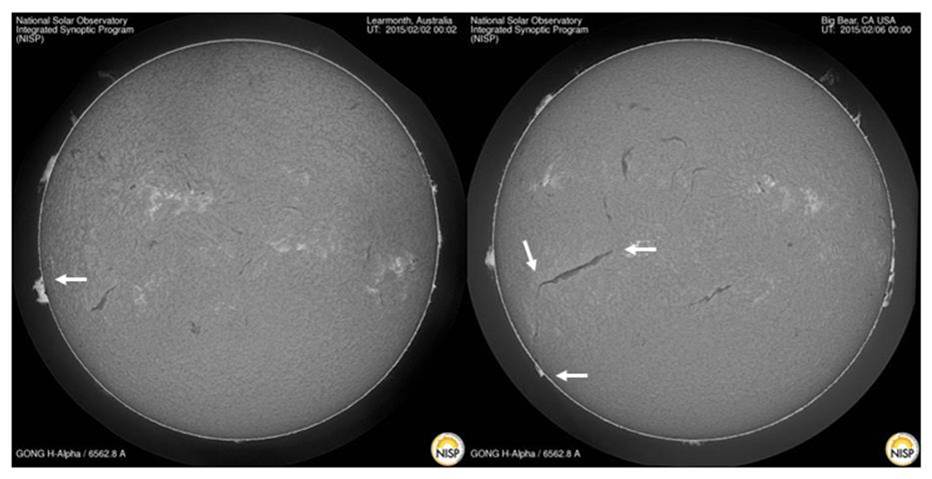
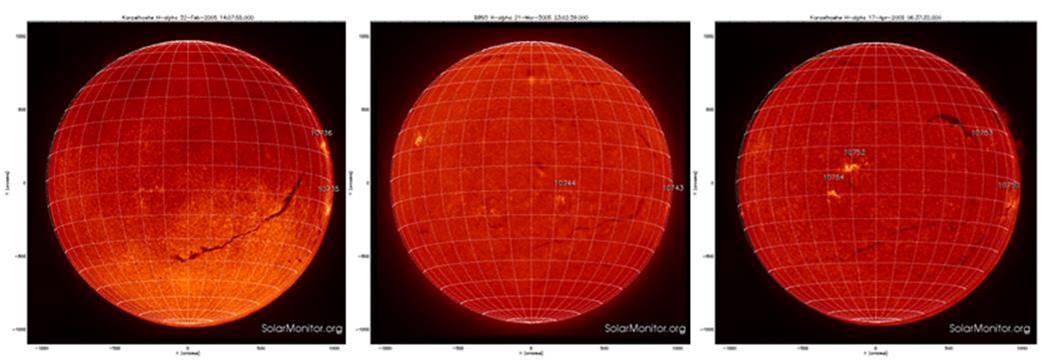
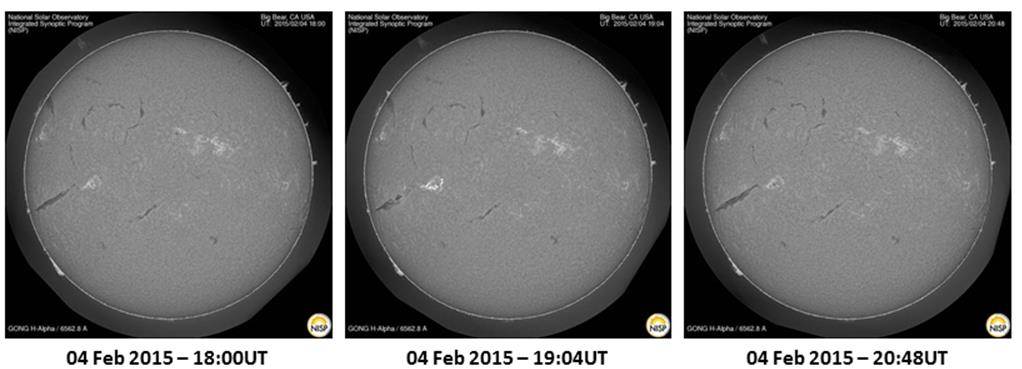
Credits - Images for the movie clips were taken from the GONG H-alpha Network (http://halpha.nso.edu/), SDO (http://sdo.gsfc.nasa.gov/data/aiahmi/), and (J)Helioviewer (http://helioviewer.org/).
Small, smaller ... next to washing machine sized micro-satellites, there exist pico-satellites. The Belgian Institute for Space Aeronomy, BIRA-IASB, together with Centre Spatial de Liege, CSL is building one of a network of 50 CubeSats. The satellite is baptised PICASSO: PICosatellite for Atmospheric and Space Science Observations and it will explore the earth atmospheric layers where no man has explored. This is exciting, but it is even more exciting that these observations are done with such a small satellite. If this technological mission proves to be successful, it opens to door for more similar and cheap missions.
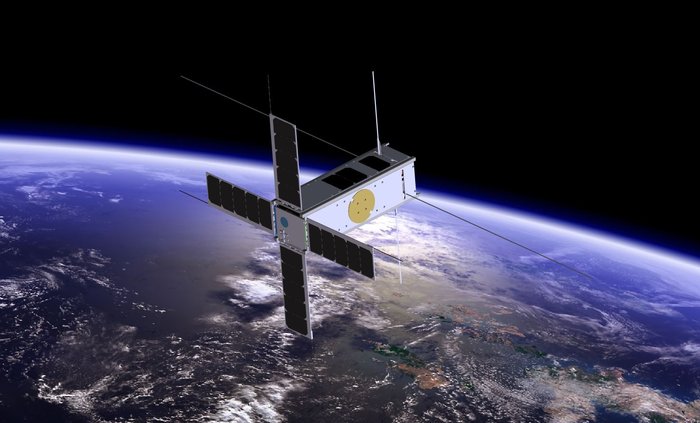
Launch is foreseen in 2016, so one year of patience before this thrilling episode can start.
Meer - Nederlands
http://www.esa.int/dut/ESA_in_your_country/Belgium_-_Nederlands/Belgisch_Instituut_voor_Ruimte-Aeronomie_gaat_ozonlaag_en_ionosfeer_bestuderen_met_picosatelliet_PICASSO
Plus - Francais
http://www.esa.int/fre/ESA_in_your_country/Belgium_-_Francais/L_Institut_d_aeronomie_spatiale_de_Belgique_veut_demontrer_la_possibilite_d_etudier_la_couche_d_ozone_et_l_ionosphere_avec_le_pico-satellite_PICASSO
More - English (short version)
http://www.esa.int/spaceinimages/Images/2015/01/Picasso_CubeSat2
Solar flare activity fluctuated between low and moderate during the week.
In order to view the activity of this week in more detail, we suggest to go to the following website from which all the daily (normal and difference) movies can be accessed:http://proba2.oma.be/ssa
This page also lists the recorded flaring events.
A weekly overview movie can be found here (SWAP week 254).
http://proba2.oma.be/swap/data/mpg/movies/weekly_movies/weekly_movie_2015_02_02.mp4
Details about some of this week's events, can be found further below.
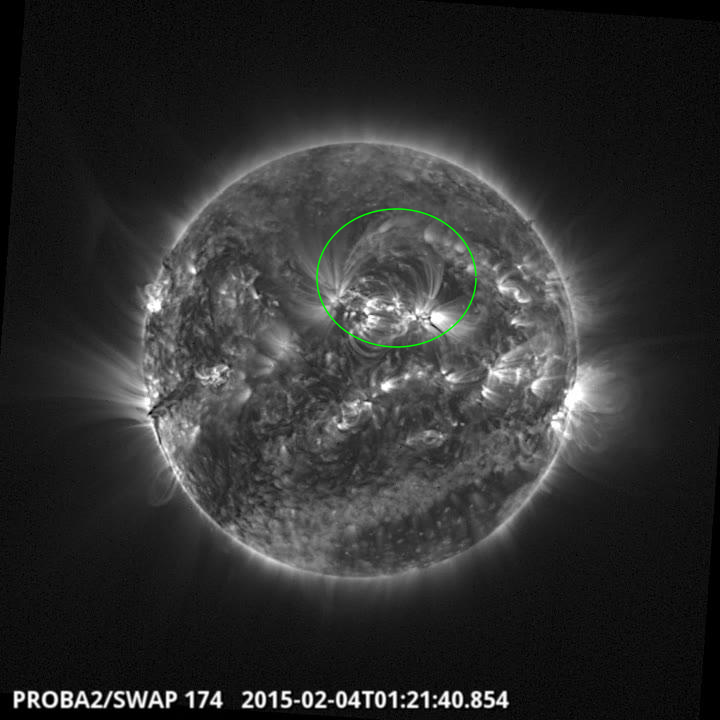
Mflare on the Suns centre @ 01:21 SWAP image
Find a movie of the event here (SWAP movie)
http://proba2.oma.be/swap/data/mpg/movies/20150204_swap_movie.mp4
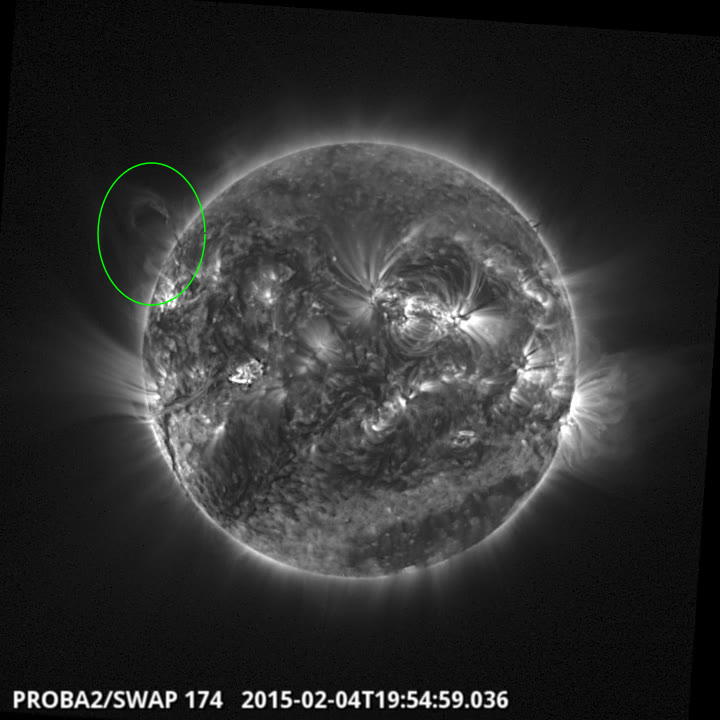
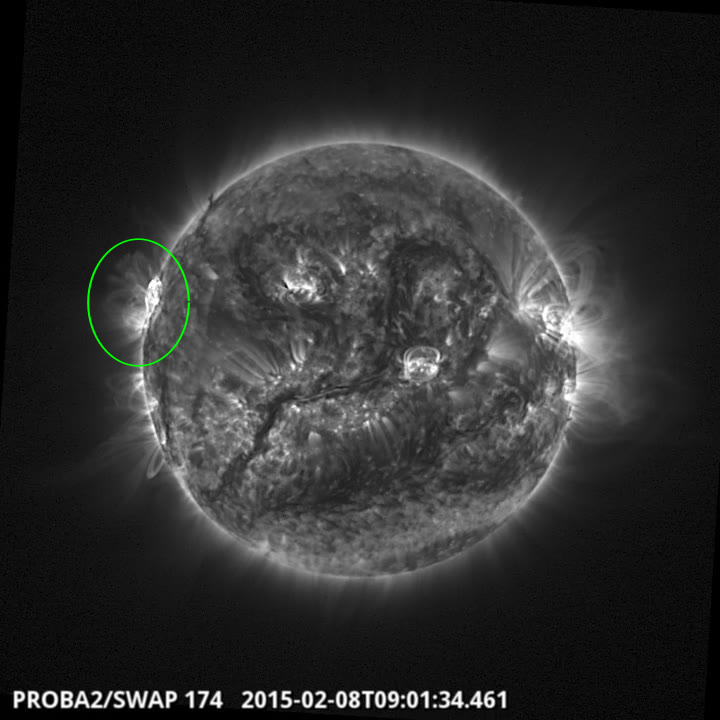
Failed eruption on the east limb @ 21:15 SWAP image
Find a movie of the event here (SWAP movie)
http://proba2.oma.be/swap/data/mpg/movies/20150208_swap_movie.mp4
Solar activity was low over the week with just a single low class M flare: an M1.2 flare peaking at 2:15UT on February 4, originating from NOAA region 2277. This region dominated the activity over the week with multiple low class C flares. Further low class C flares were produced by the other regions on disc as well: 2268 as it rotated out of view on the west limb, 2280 moving from the eastern to the western hemisphere over the week, and 2281 and 2282 both rotating into view on the eastern hemisphere.
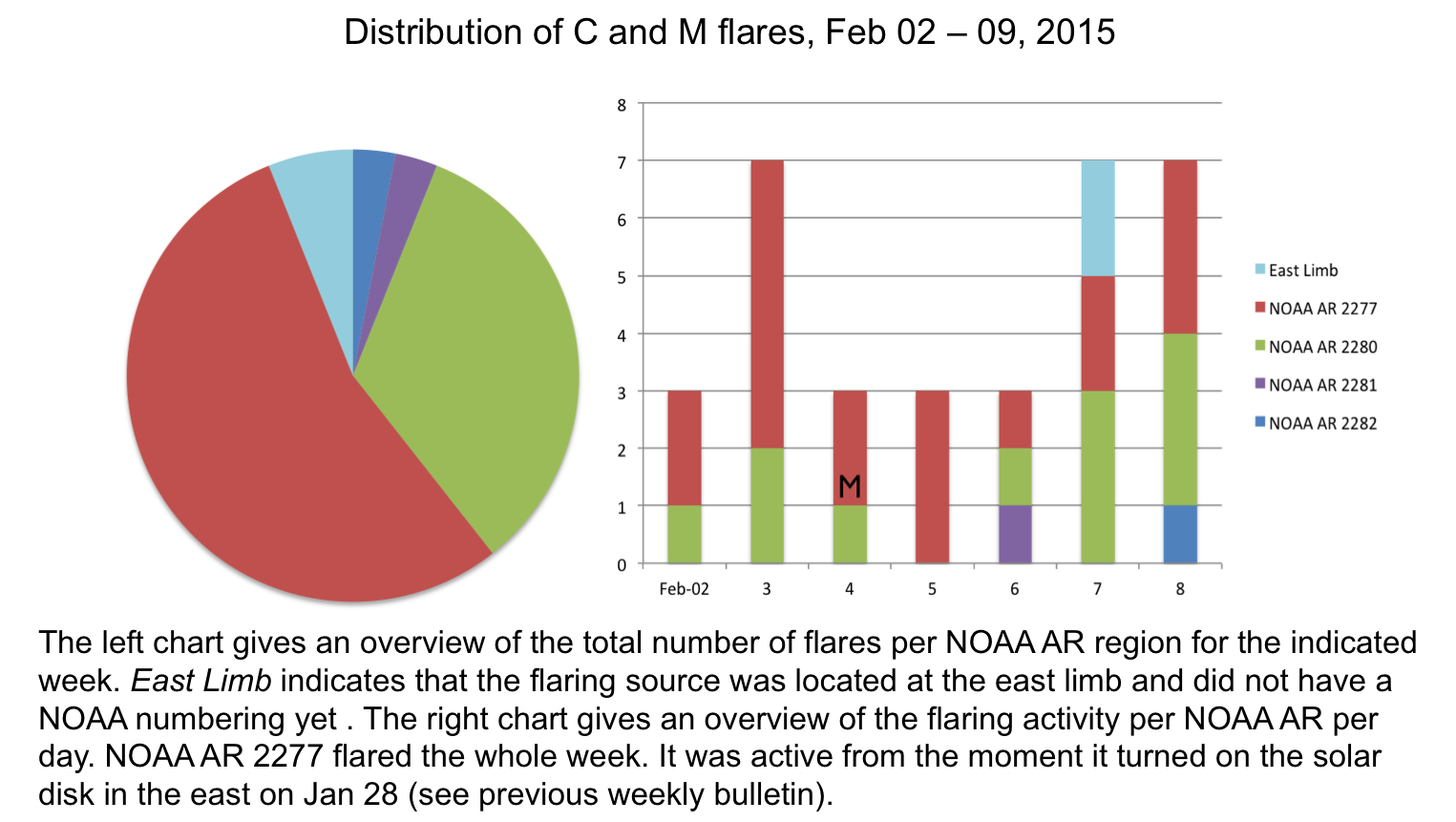
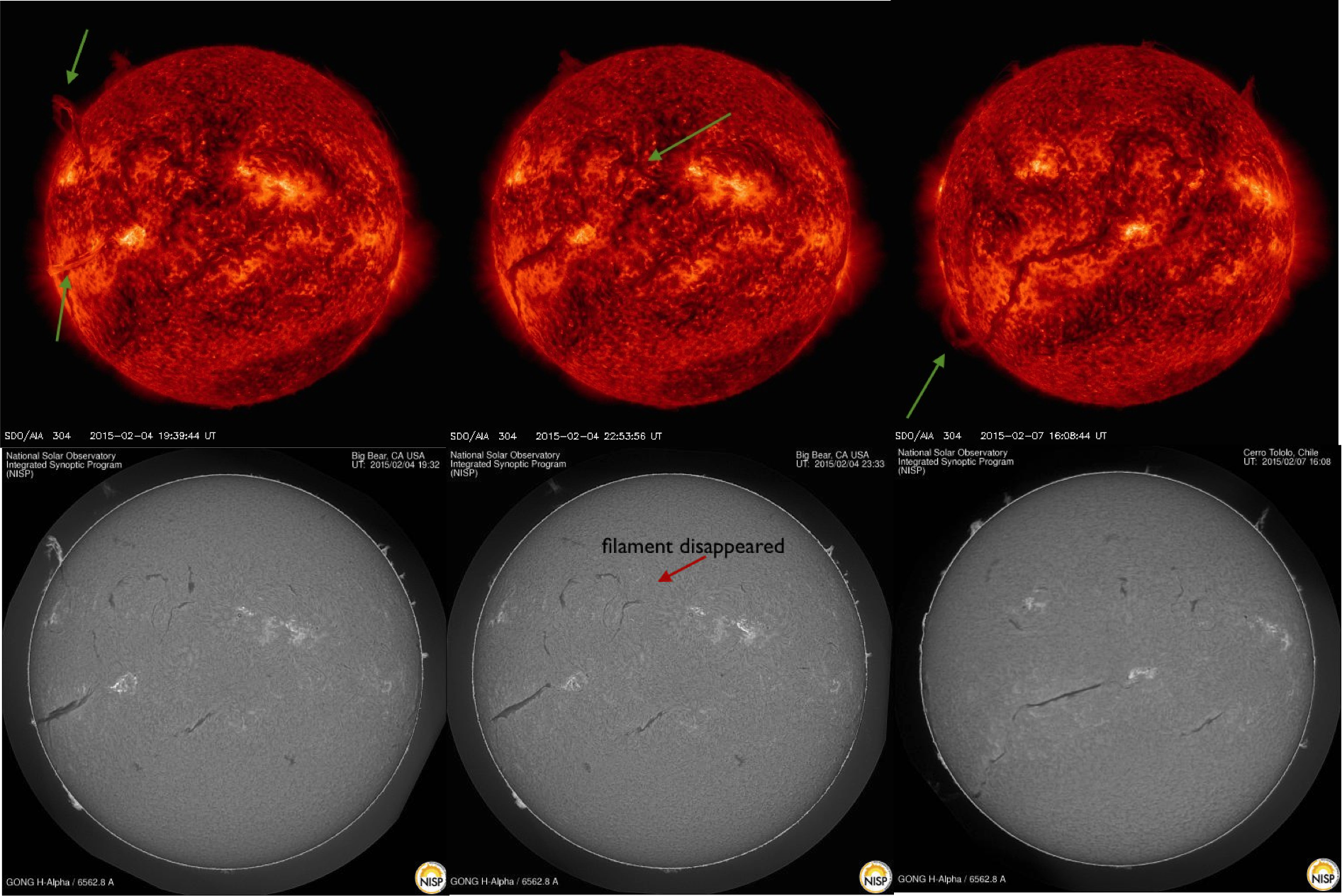
| DAY | BEGIN | MAX | END | LOC | XRAY | OP | 10CM | TYPE | Cat | NOAA |
| 04 | 0208 | 0215 | 0221 | N10W14 | M1.2 | 2N | III/1 | 78 | 2277 |
| LOC: approximate heliographic location | TYPE: radio burst type |
| XRAY: X-ray flare class | Cat: Catania sunspot group number |
| OP: optical flare class | NOAA: NOAA active region number |
| 10CM: peak 10 cm radio flux |
Solar wind was marked by the influence of a high speed solar wind (HSS) during the first days of the week reaching speeds of 750 km/s and with Bz reaching peaks of -12nT.
Geomagnetic conditions were active during this period (NOAA Kp 4) with locally even a minor geomagnetic storm (K Dourbes 4). solar wind conditions then slowly recovered. Geomagnetic conditions were otherwise quiet to unsettled apart form another period of active geomagnetic conditions, associated with a shift of the magnetic field phi angle form negative to positive on February 5.
Solar wind speed increased again at the end of the week under the influence of another HSS.
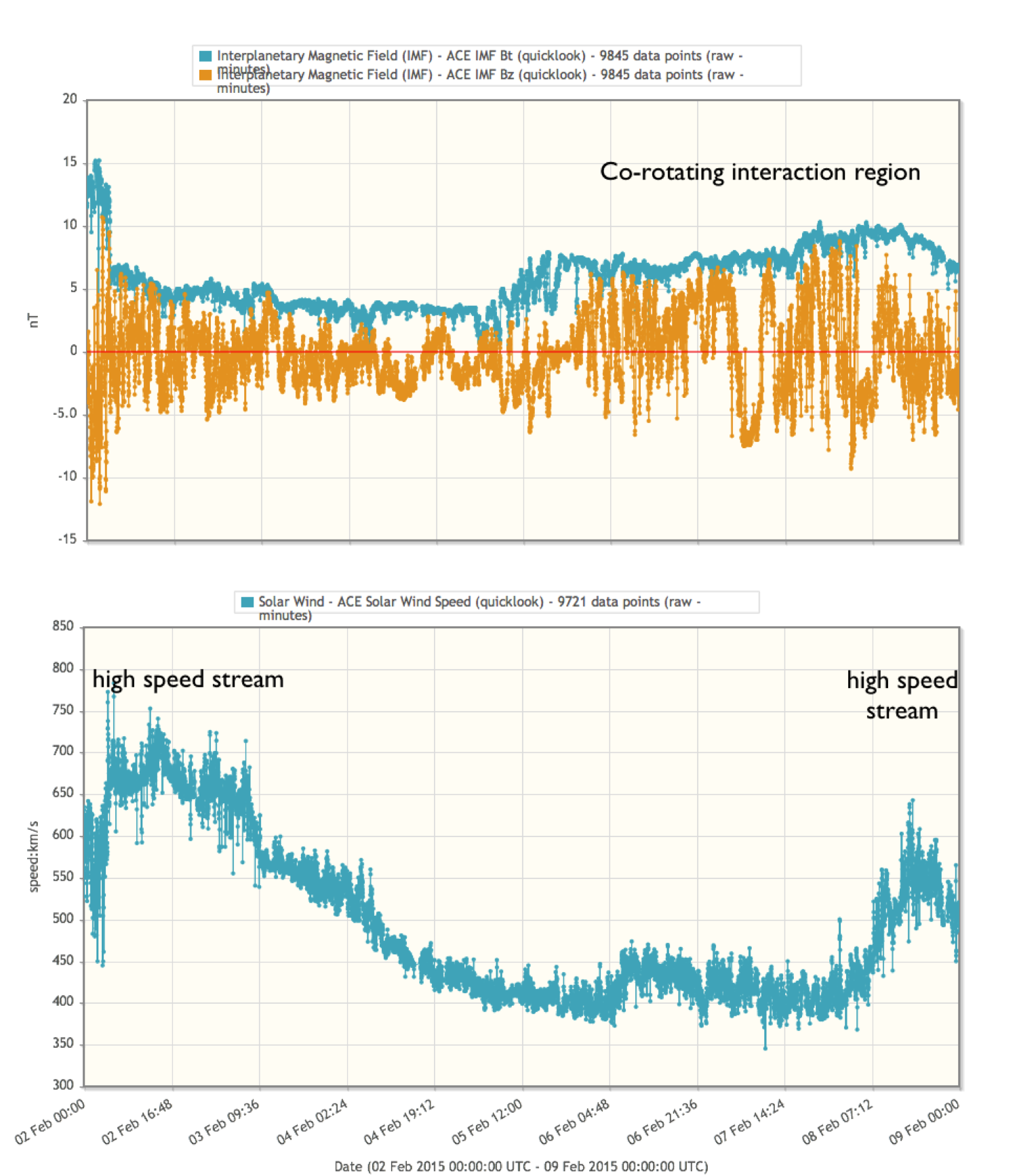
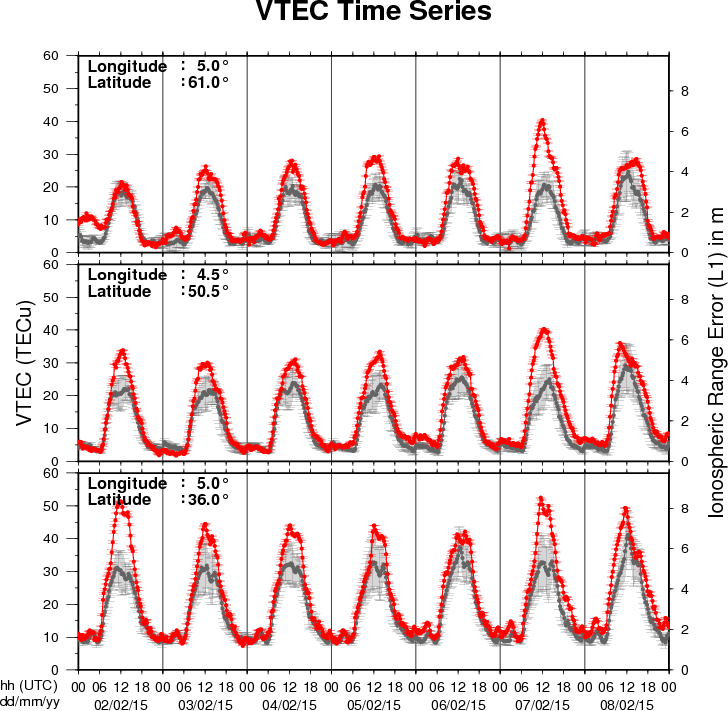
The figure shows the time evolution of the Vertical Total Electron Content (VTEC) (in red) during the last week at three locations:
a) in the northern part of Europe(N61°, 5°E)
b) above Brussels(N50.5°, 4.5°E)
c) in the southern part of Europe(N36°, 5°E)
This figure also shows (in grey) the normal ionospheric behaviour expected based on the median VTEC from the 15 previous days.
The VTEC is expressed in TECu (with TECu=10^16 electrons per square meter) and is directly related to the signal propagation delay due to the ionosphere (in figure: delay on GPS L1 frequency).
The Sun's radiation ionizes the Earth's upper atmosphere, the ionosphere, located from about 60km to 1000km above the Earth's surface.The ionization process in the ionosphere produces ions and free electrons. These electrons perturb the propagation of the GNSS (Global Navigation Satellite System) signals by inducing a so-called ionospheric delay.
See http://stce.be/newsletter/GNSS_final.pdf for some more explanations ; for detailed information, see http://gnss.be/ionosphere_tutorial.php
Start : 2015-03-16 - End : 2015-03-19
This international conference will provide an overview of our
current understanding of Sun-Climate Connections starting at
processes on the Sun itself over space weather and solar wind
towards solar influence on the upper atmosphere down to the ocean.
It will also provide insights into the heatedly debated role of the
Sun in climate change. In four sessions the various contributions
of solar variability influence on Earth's climate will be presented
and discussed by bringing together solar physicists, space
scientists, atmospheric scientists, climate modellers, and
paleoclimatologists.
We expect contributions from scientists participating in
SCOSTEP/ROSMIC, SPARC-SOLARIS/HEPPA, the EU cost network TOSCA, as
well as any other interested scientists. The conference will last
three full days, beginning Monday morning, 16 March 2013. The
programme will consist of invited and keynote lectures, a few
contributed oral presentations and ample time dedicated to poster
sessions. The fourth day will be devoted to public outreach
activities as well as panel discussions.
Website: http://scc.geomar.de/
Start : 2015-05-18 - End : 2015-05-22
URSI AT-RASC 2015 will be the first edition of the newly
established triennial URSI Atlantic Radio Science Conference as one
of the URSI Flagship Conferences. AT-RASC 2015 will have an open
scientific program composed of submitted papers within the domains
covered by all ten Commissions of URSI.
Website: http://www.at-rasc.com/
Start : 2015-05-25 - End : 2015-05-29
25-27 May 2015: BUKS 2015 - MHD waves: Observational aspects
from ground to space - MHD waves: Theory - where are we? - MHD
instabilities
27-28 May 2015: Ruderman Honorary meeting - Theory of linear MHD
waves - MHD waves instabilities - Non-linear waves in plasmas
29 May 2015: Joint BUKS/Ruderman's conferences excursion -
Boat excursion to Szentendre, Visegrad and Esztergom
Website:
http://swat.group.shef.ac.uk/Conferences/BUKS_2015/index.html
Start : 2015-06-01 - End : 2015-07-24
The Space Weather Summer School at Los Alamos National
Laboratory, established in 2011 under the founding Director Josef
Koller, is dedicated to space weather, space science and
applications. Every year we solicit applications for the Los Alamos
Space Weather Summer School. This summer school is sponsored and
supported by a number or organizations at LANL. This year our top
sponsors include the Los Alamos Institute of Geophysics, Planetary
Physics and Signatures (IGPPS) and the Laboratory Directed Research
and Development Office (LDRD). The summer school brings together
top space science students with internationally recognized
researchers at LANL in an educational and collaborative
atmosphere.
Website:
http://www.swx-school.lanl.gov/
Start : 2015-06-09 - End : 2015-06-12
The last five years have seen substantial progress in our
understanding of the solar dynamo, fueled by continuing advances in
observations and modeling. With the launch of NASA's Solar Dynamics
Observatory (SDO) in 2010 came an unprecedented window on the
evolving magnetic topology of the Sun, highlighting its intricate
3D structure and global connectivity. The Helioseismic Magnetic
Imager (HMI) instrument on SDO in particular has provided
potentially transformative yet enigmatic insights into the internal
dynamics of the solar convection zone that underlie the dynamo.
Attempts to detect subsurface convective motions from helioseismic
inversions have yielded only upper limits on the large-scale
convective amplitude, challenging our understanding of global solar
convection. Yet, potential signatures of giant cells have been
detected in photospheric Dopplergrams. Estimates of the meridional
flow from HMI and complementary instruments (SOHO/MDI and GONG)
have been equally tantalizing and enigmatic. Several disparate
techniques, including local and global helioseismic inversions and
correlation tracking of surface features, have yielded evidence of
a multi-cellular meridional flow but they differ on the detailed
flow structure and amplitude. This multi-cellular meridional flow
has potentially profound implications for flux-transport dynamo
models that previously assumed a very different structure with a
single circulation cell per hemisphere.
Website:
https://www2.hao.ucar.edu/Workshop/Solar-Dynamo-Frontiers
Start : 2015-07-13 - End : 2015-07-24
The CISM Summer School is intended to give students a
comprehensive immersion in the subject of space weather: what it
is, what it does, and what can be done about it. Space weather is
many things: beautiful when seen through the eyes of a sun-viewing
telescope, fascinating when studied for its alien worlds of
magnetic structures and phenomena, awesome when witnessed as a
solar eruption or auroral storm, and devastating to the users of
services it disrupts. Space weather links the Sun, the Earth, and
the space in between in a branching chain of consequences. Weather
systems on the Sun can spawn interplanetary storms of colossal size
and energy that envelop the whole planet in electrical hurricanes.
Such storms attack high-tech, complex, and expensive technological
systems that provide much of the infrastructure that allows modern
society to function.
Website:
https://www2.hao.ucar.edu/Events/2015-CISM-Summer-School
Start : 2015-07-21 - End : 2015-07-23
The conference will review past and recent achievements, as well
as future challenges in the field of solar coronal loop
physics.
Website:
http://www.damtp.cam.ac.uk/user/astro/cl7/index.html
Start : 2015-07-28 - End : 2015-08-04
Heliophysics is all of the science common to the field of the
Sun-Earth connections. This fast-developing field of research
covers many traditional sub-disciplines of space physics,
astrophysics, and climate studies. The NASA Living with a Star
program, with its focus on the basic science underlying all aspects
of space weather, acts as a catalyst to bring the many research
disciplines together to deepen our understanding of the system of
systems formed by the Sun-Earth connection.
Website:
http://www.heliophysics.ucar.edu/
Start : 2015-07-30 - End : 2015-08-06
The 34th International Cosmic Ray Conference (ICRC) will be held
from July 30 to August 6, 2015, in The Hague, The Netherlands. It
is an important and large conference in the field of Astroparticle
Physics. The ICRC covers: cosmic-ray physics, solar and
heliospheric physics, gamma-ray astronomy, neutrino astronomy, and
dark matter physics.
Website: http://icrc2015.nl
Start : 2015-10-05 - End : 2015-10-09
This CSPM-2015 scientific meeting will cover various aspects of
solar dynamic and magnetic phenomena which are observed over the
entire electromagnetic spectrum: white-light, Hα, Ca II,
and radio from ground and in a variety of other wavelengths (white
light, UV and EUV, and X-rays) from space. Emphasis will also be
placed on instrumentation, observing techniques, and solar image
processing techniques, as well as theory and modelling through
detailed radiative transfer in increasingly realistic MHD models.
The long-term (cyclic) evolution of solar magnetism and its
consequence for the solar atmosphere, eruptive phenomena, solar
irradiation variations, and space weather, will be in focus. Here,
special attention will be devoted to the long-term observations
made in Coimbra and also to the results of the SPRING / SOLARNET
and SCOSTEP VarSITI studies. In particular, the weak solar activity
during the current solar maximum will be discussed. Finally, since
this meeting is organised around the 90th anniversary of performing
the first spectroheliographic observations in Coimbra, a session
will be specially dedicated to new solar instruments (both
ground-based and space-borne) that will give access to unexplored
solar atmospheric features and dynamic phenomena over the coming
years.
Website:
http://www.mat.uc.pt/~cspm2015/
Start : 2016-07-30 - End : 2016-08-07
The 41st COSPAR Scientific Assembly will be held in Istanbul,
Turkey from 30 July - 7 August 2016. This Assembly is open to all
bona fide scientists.
Website:
https://www.cospar-assembly.org/